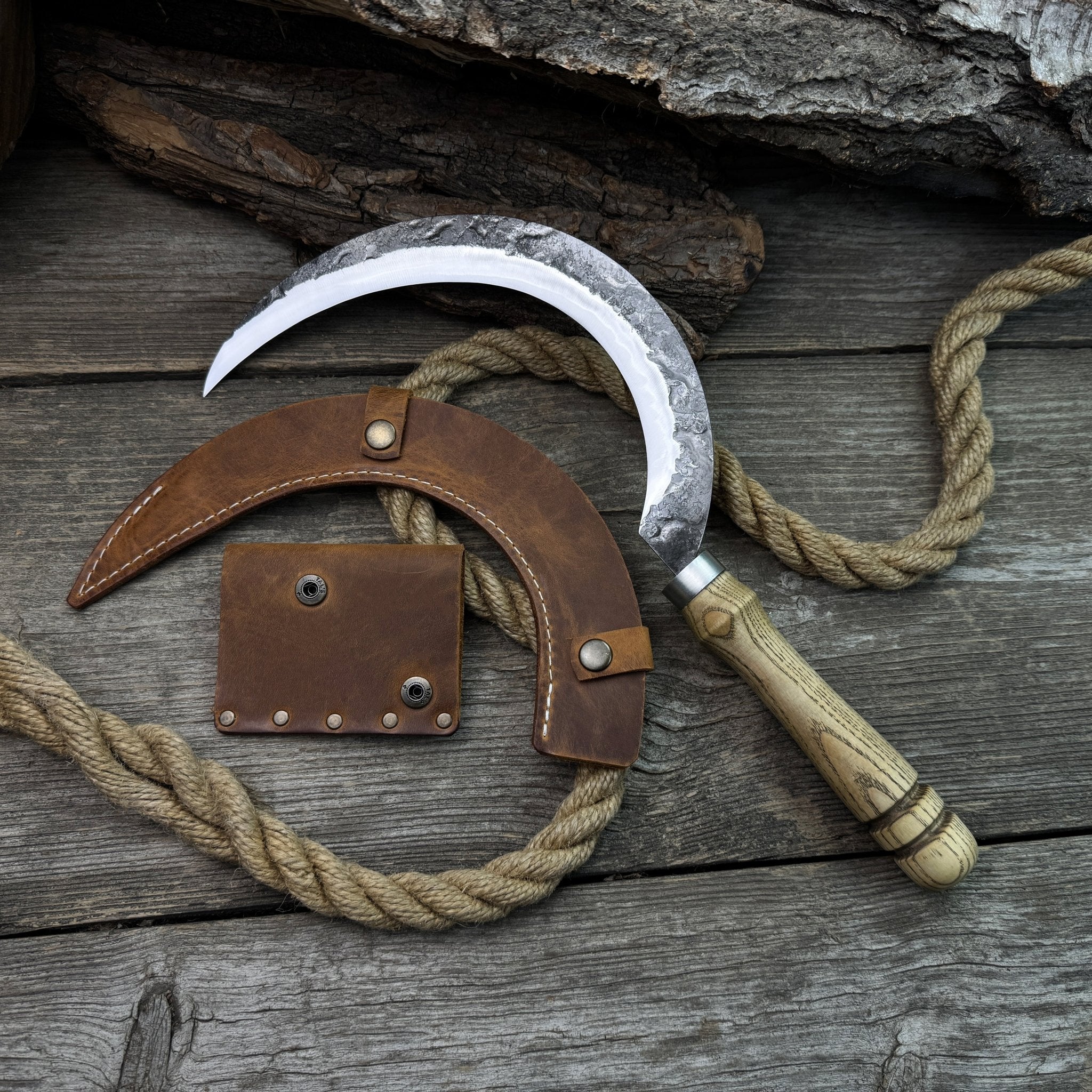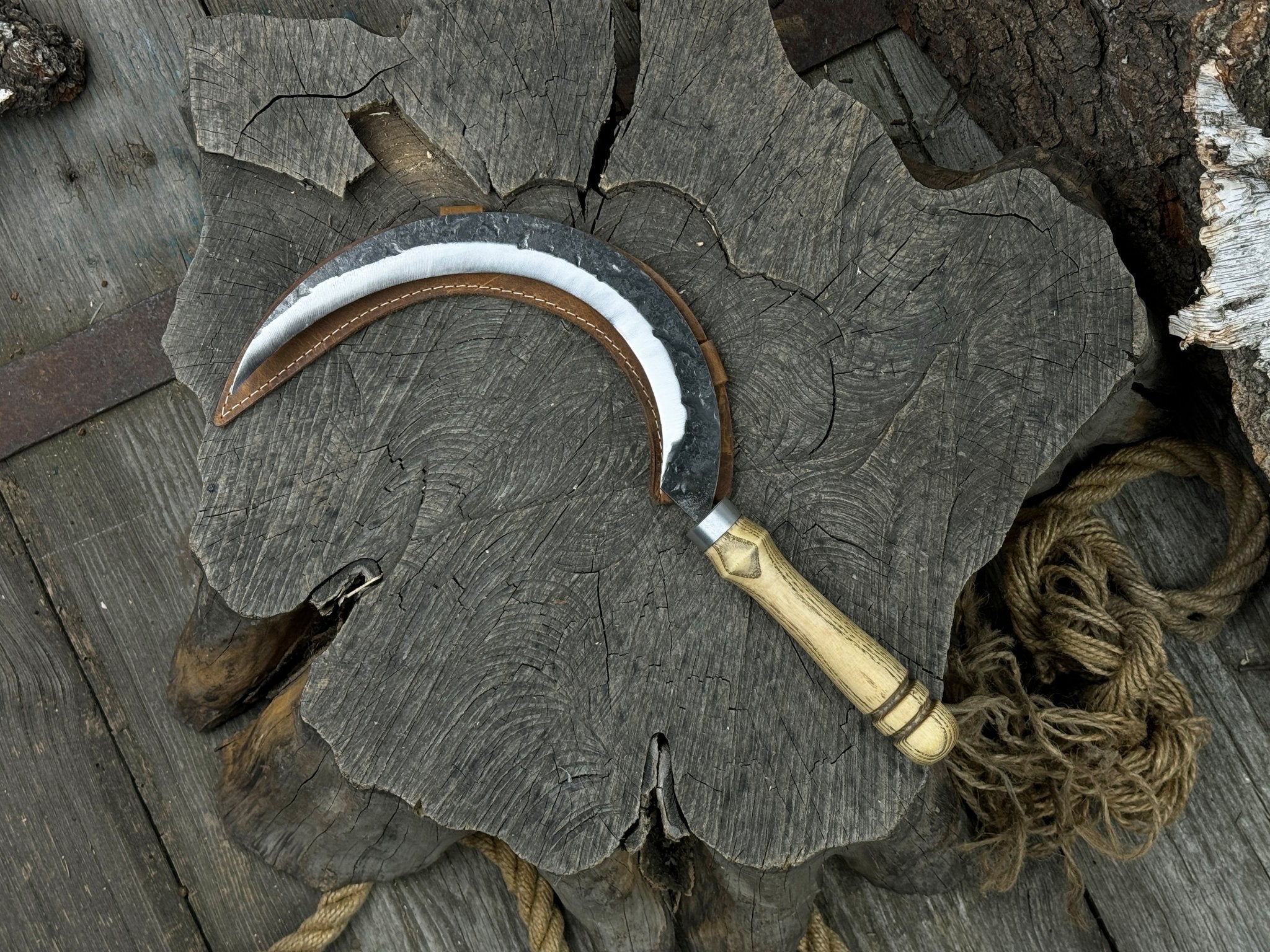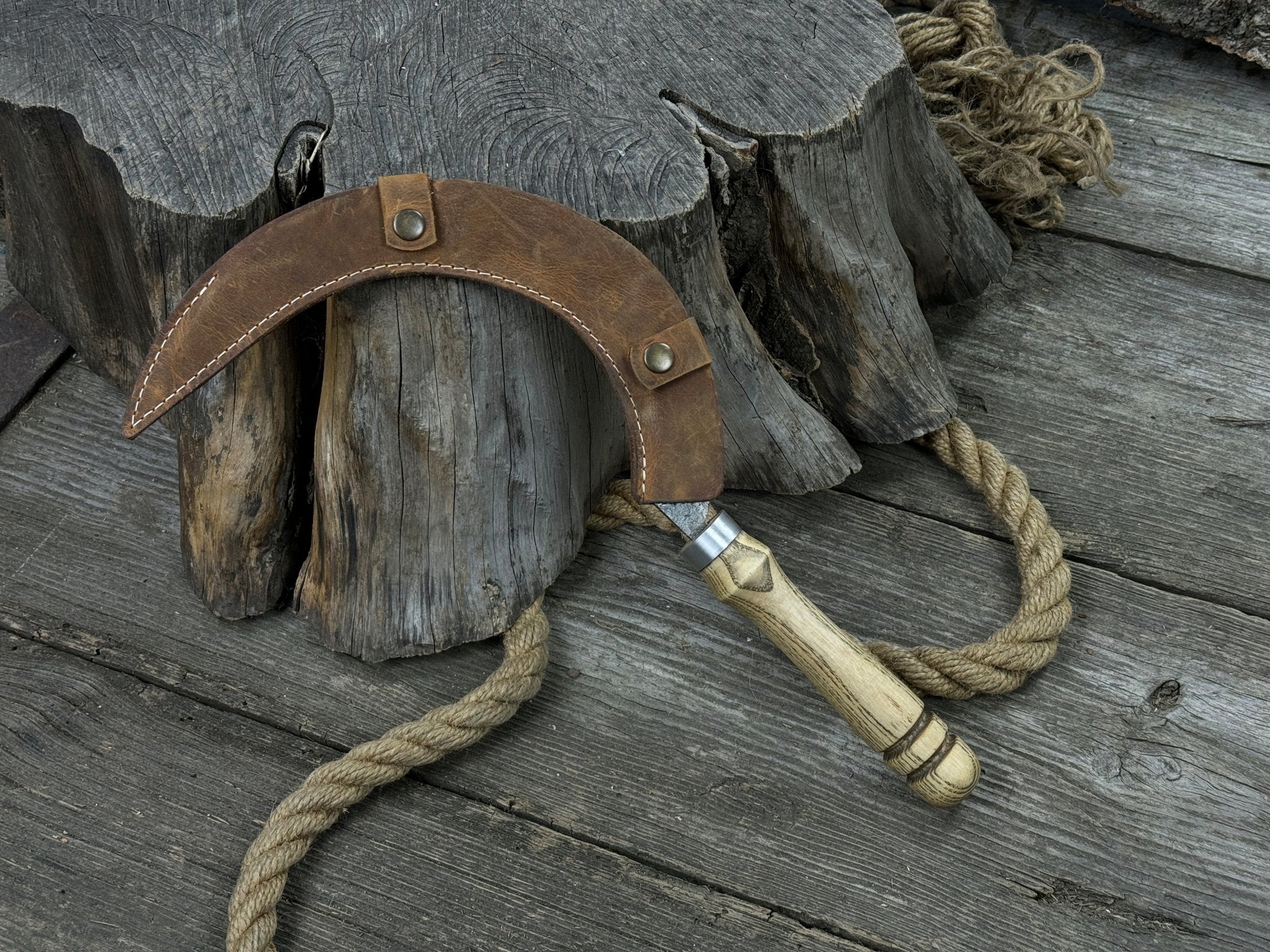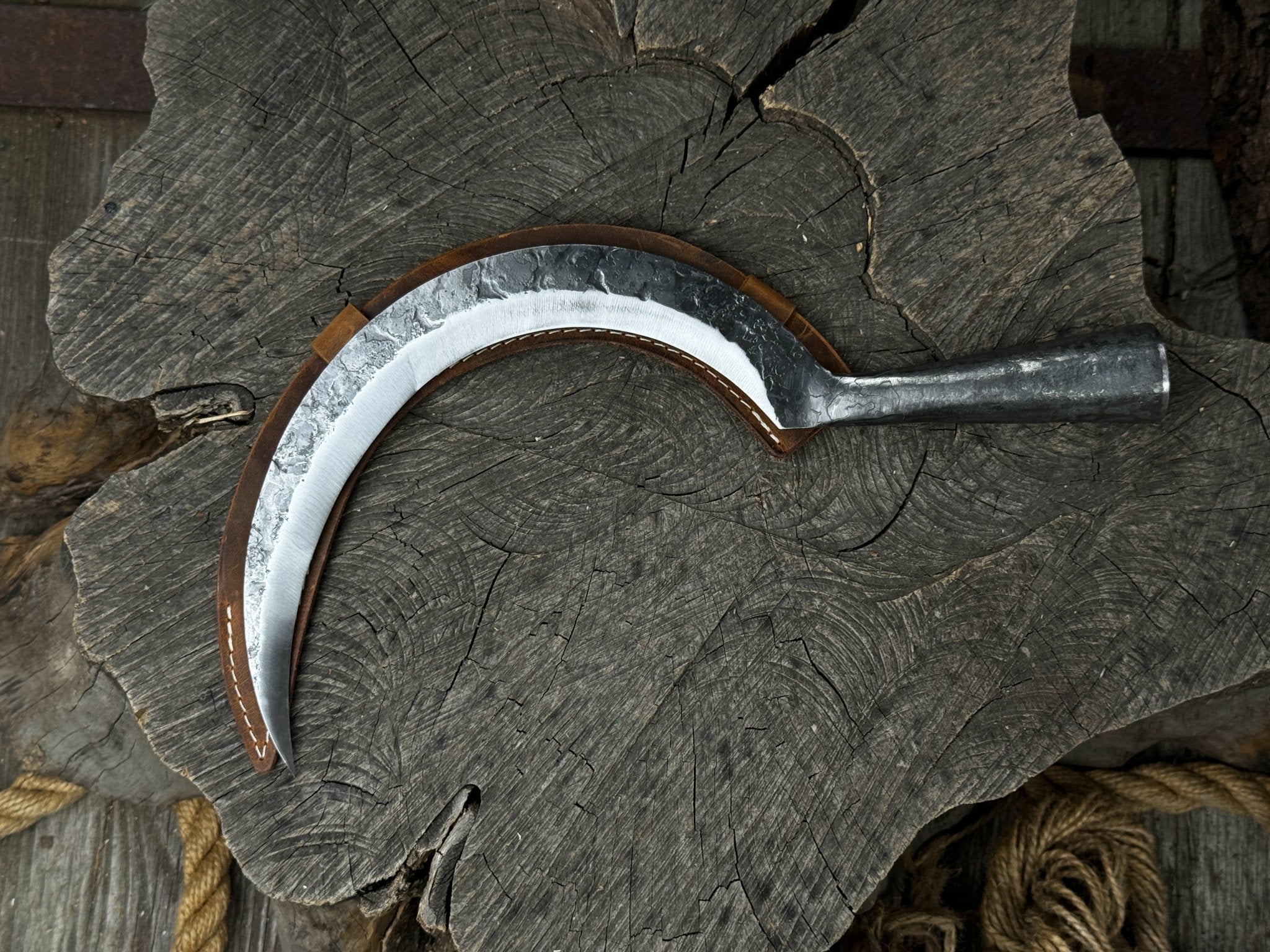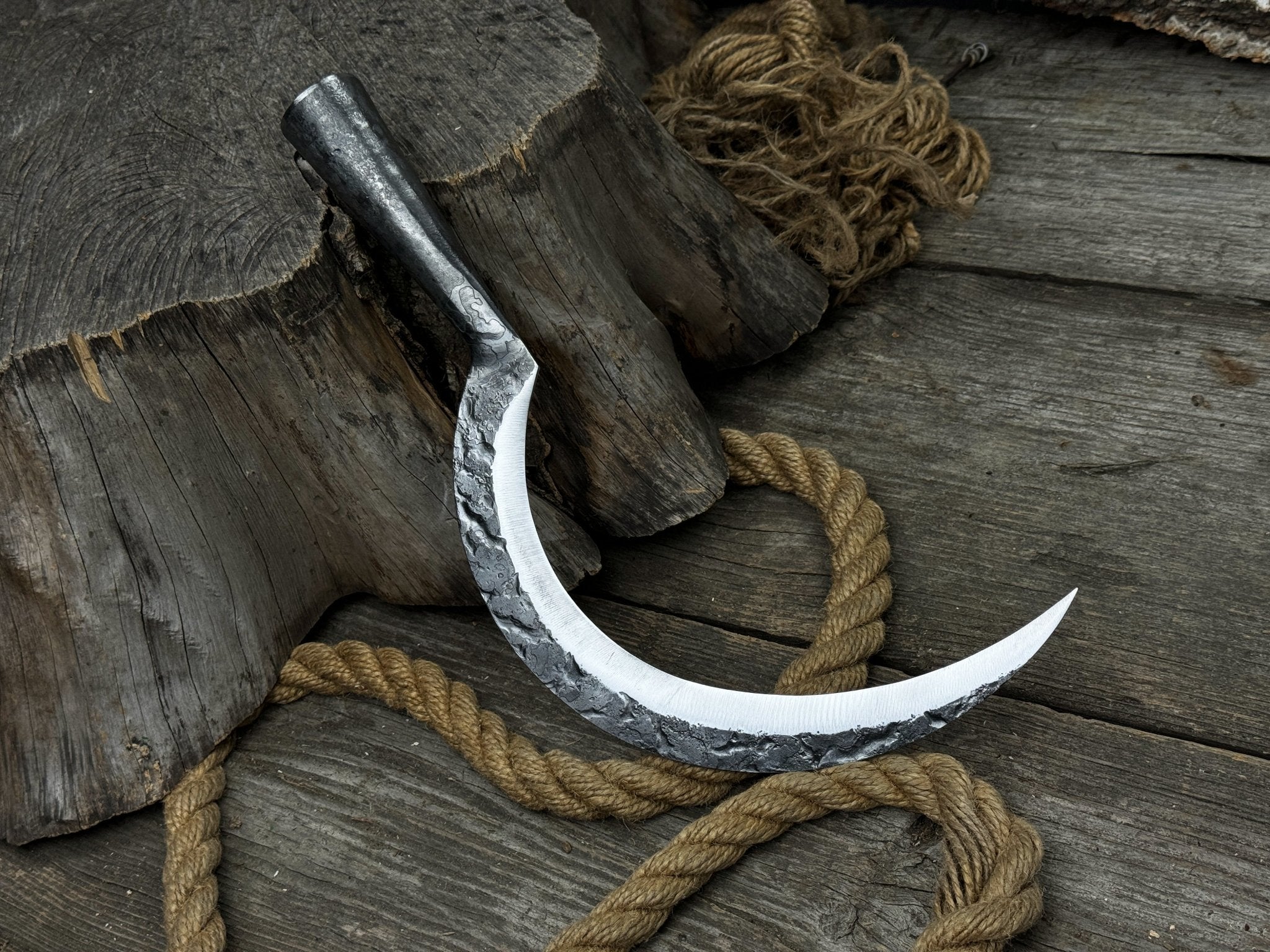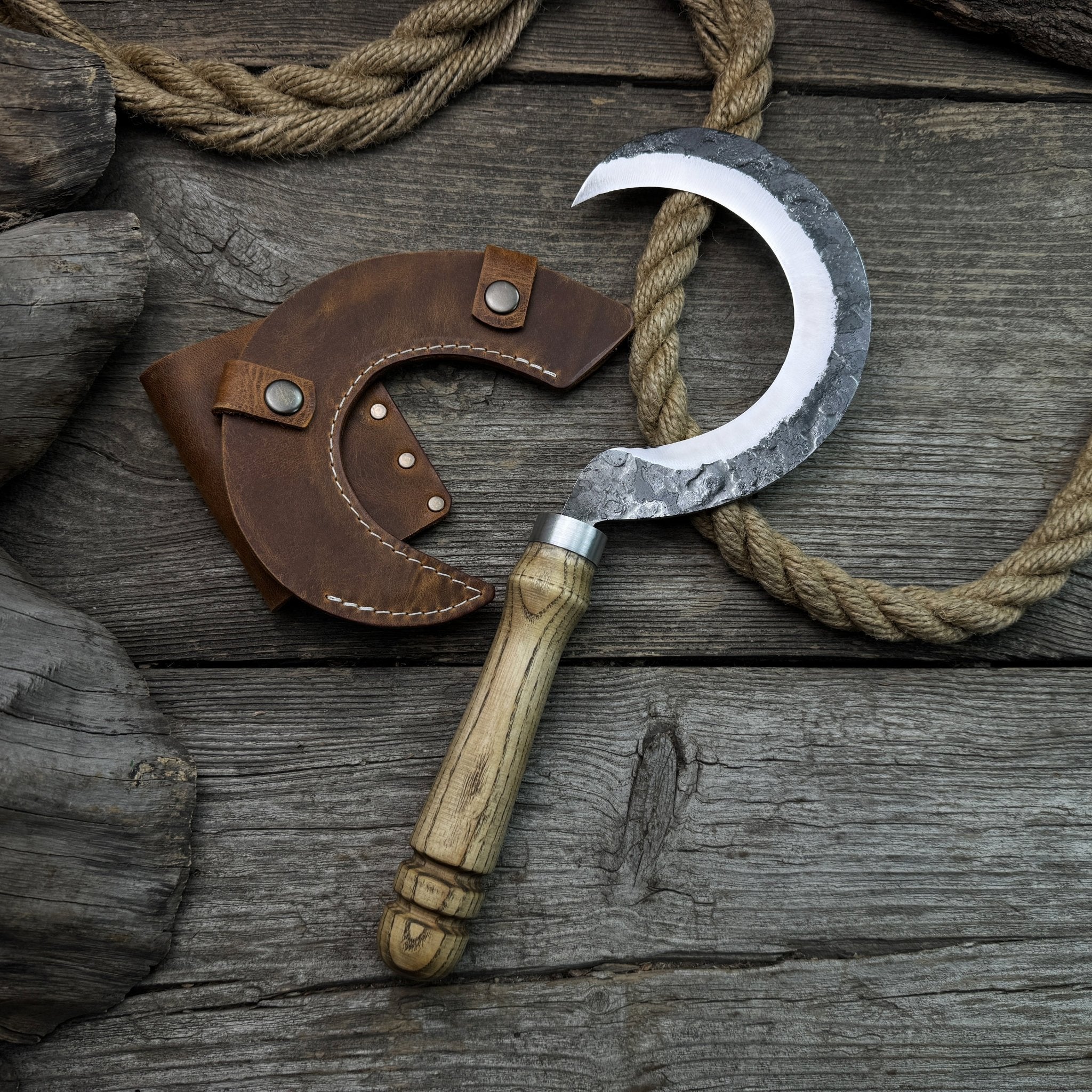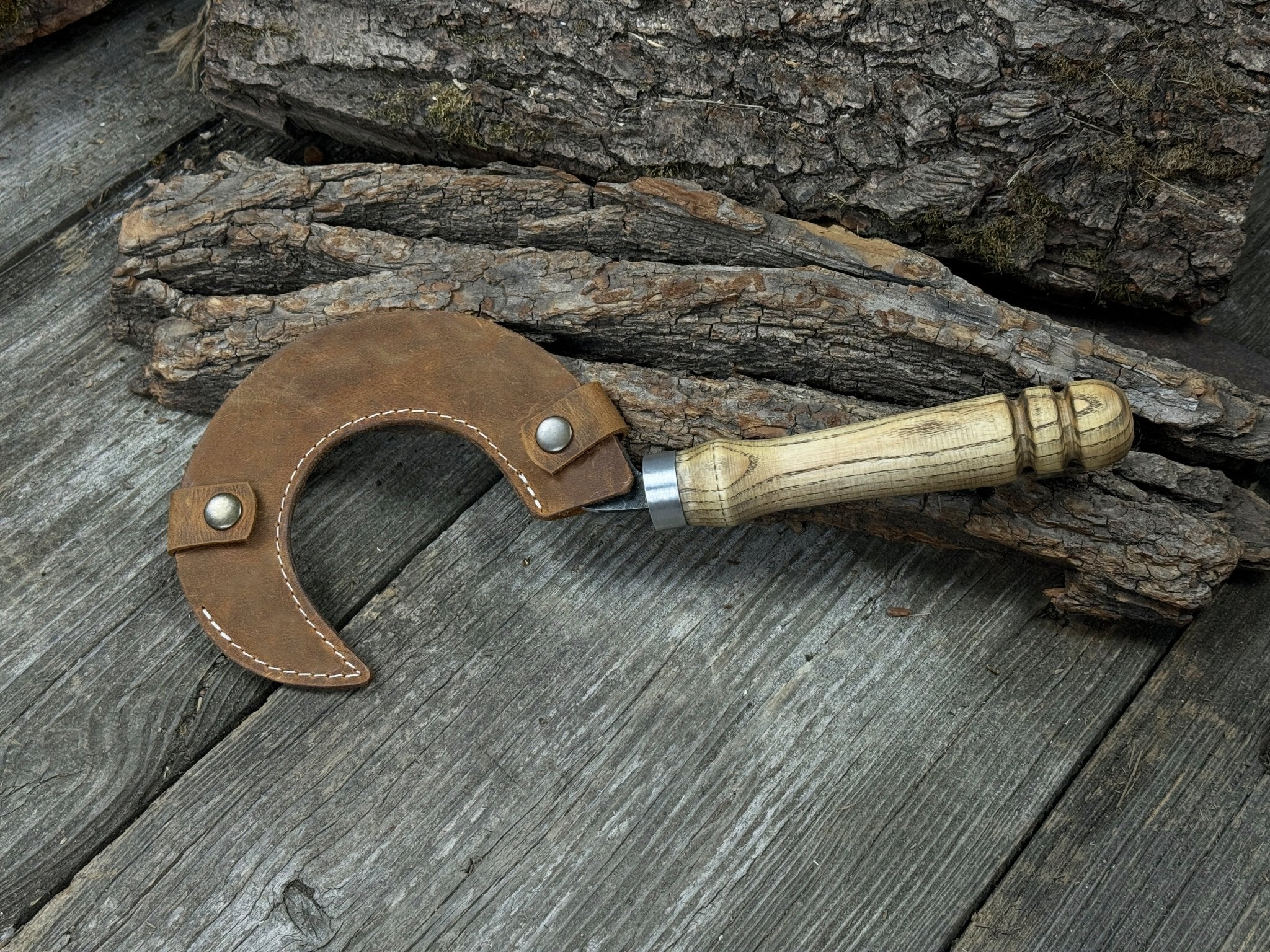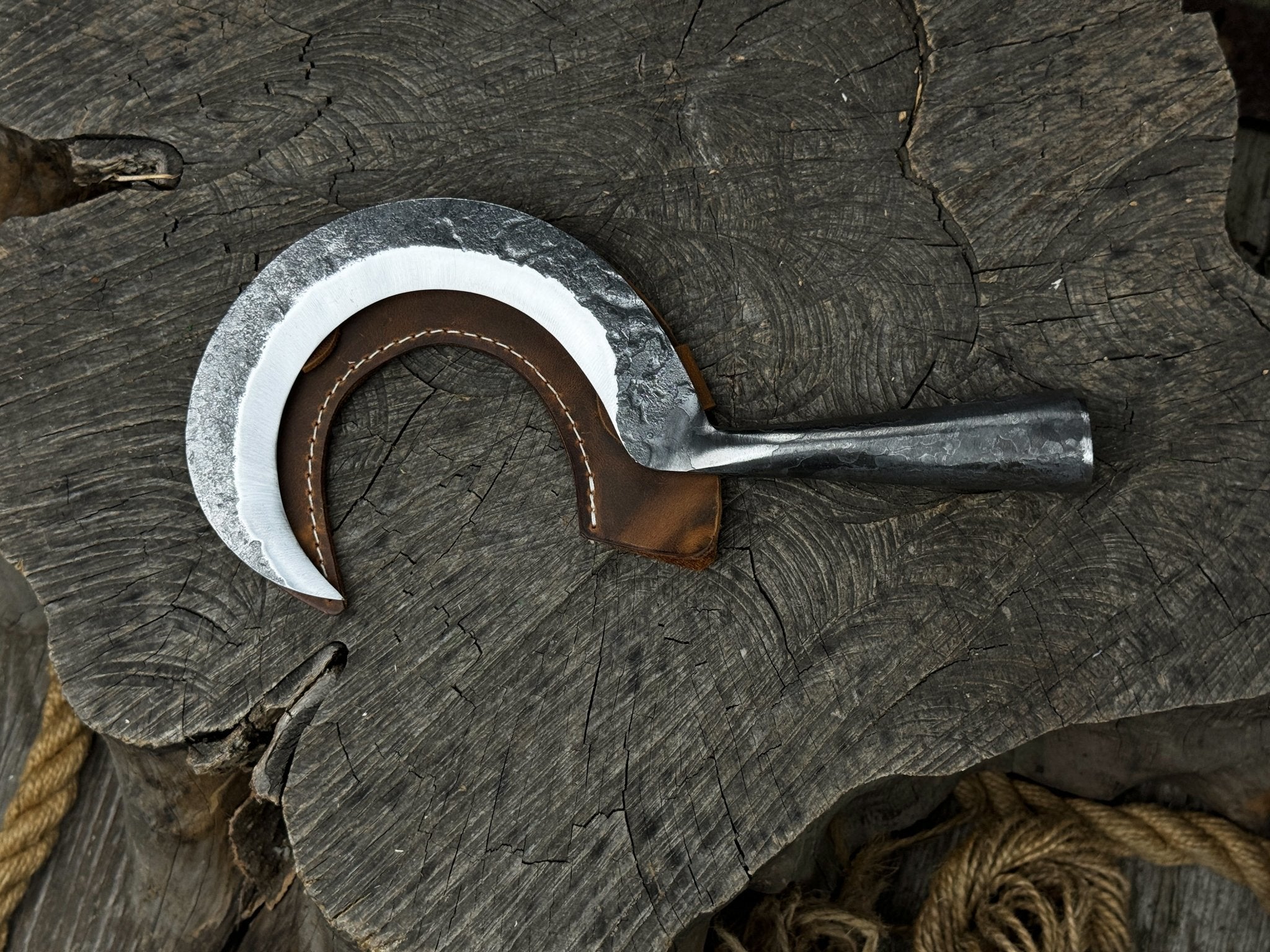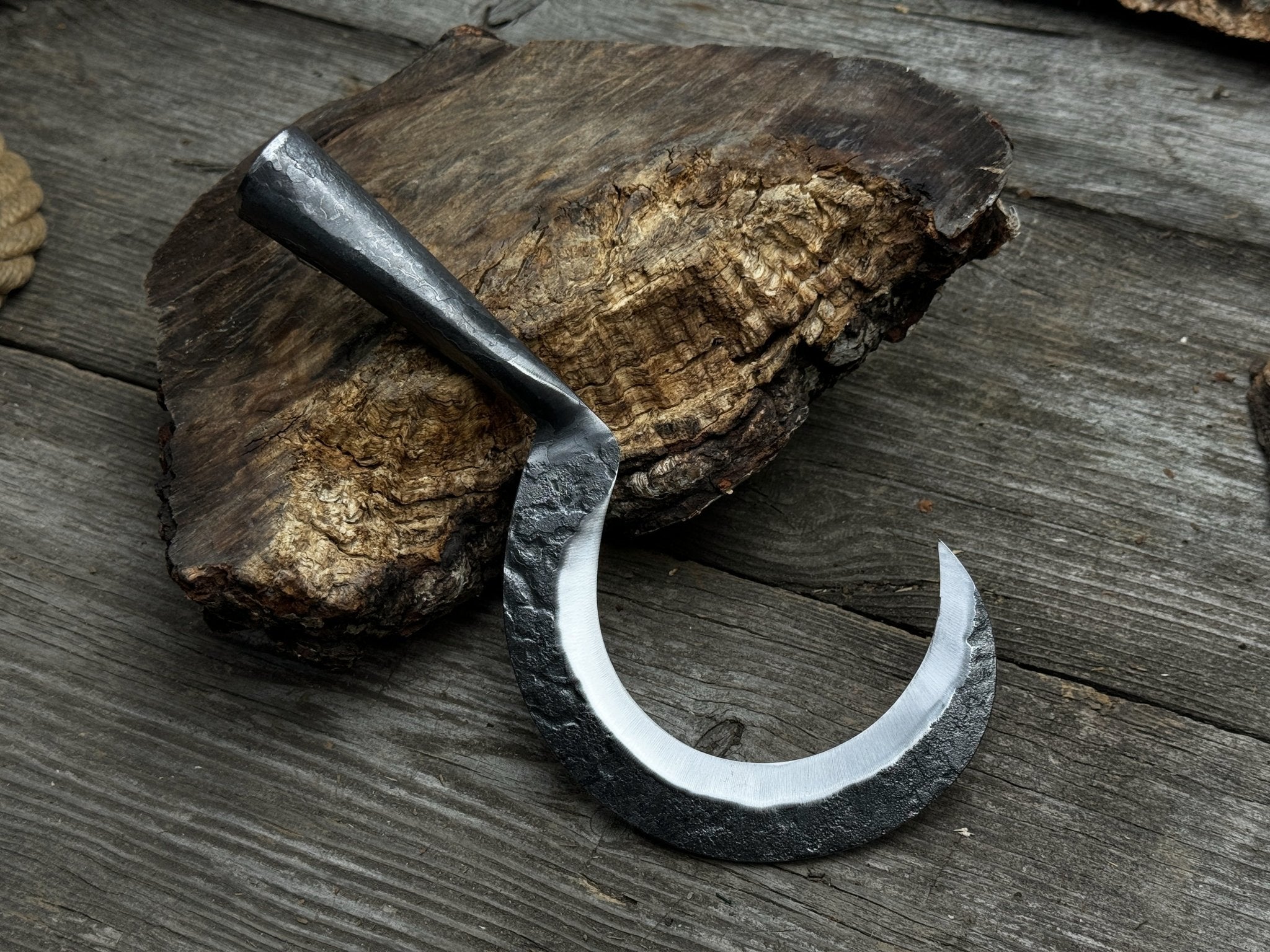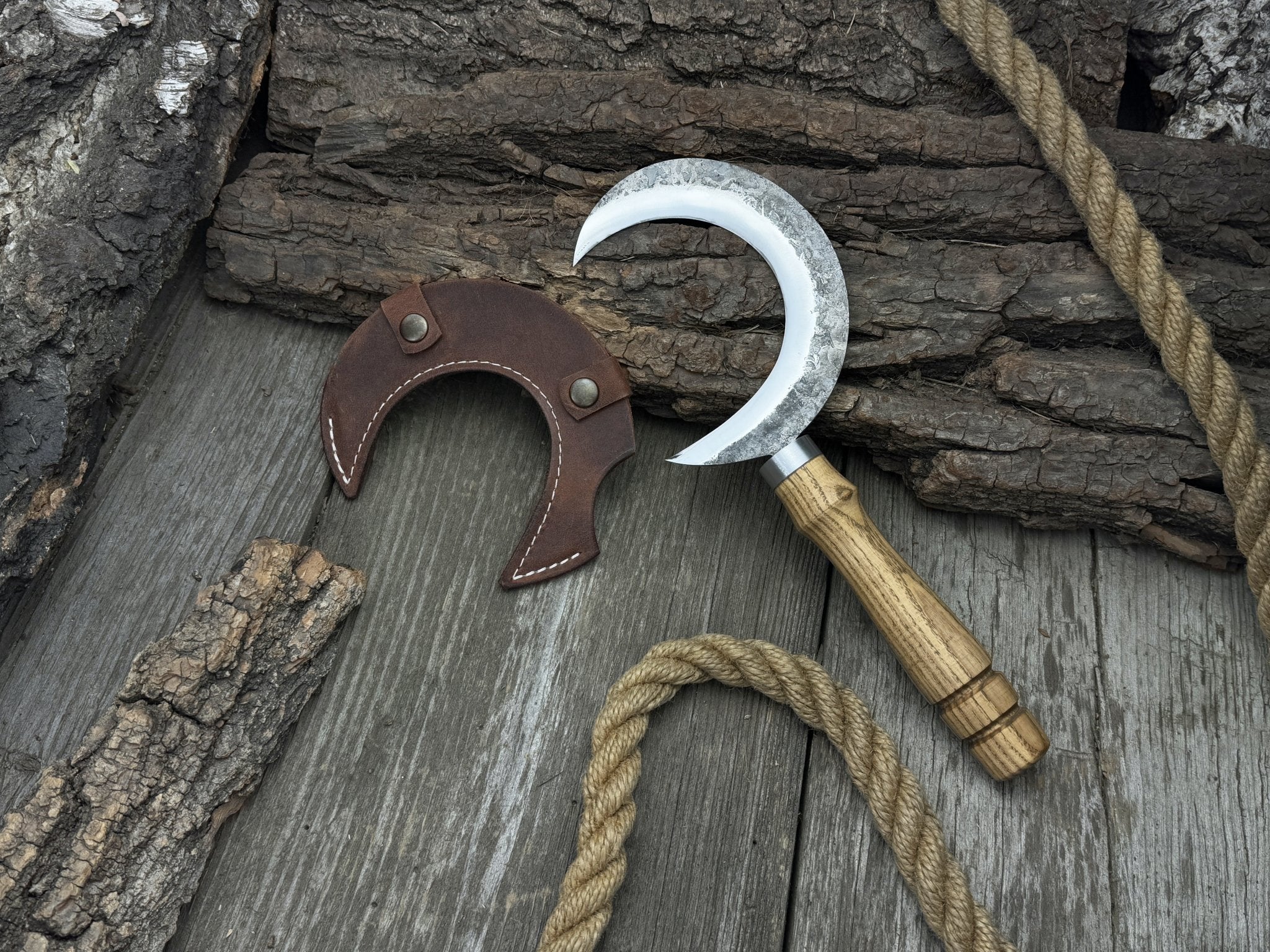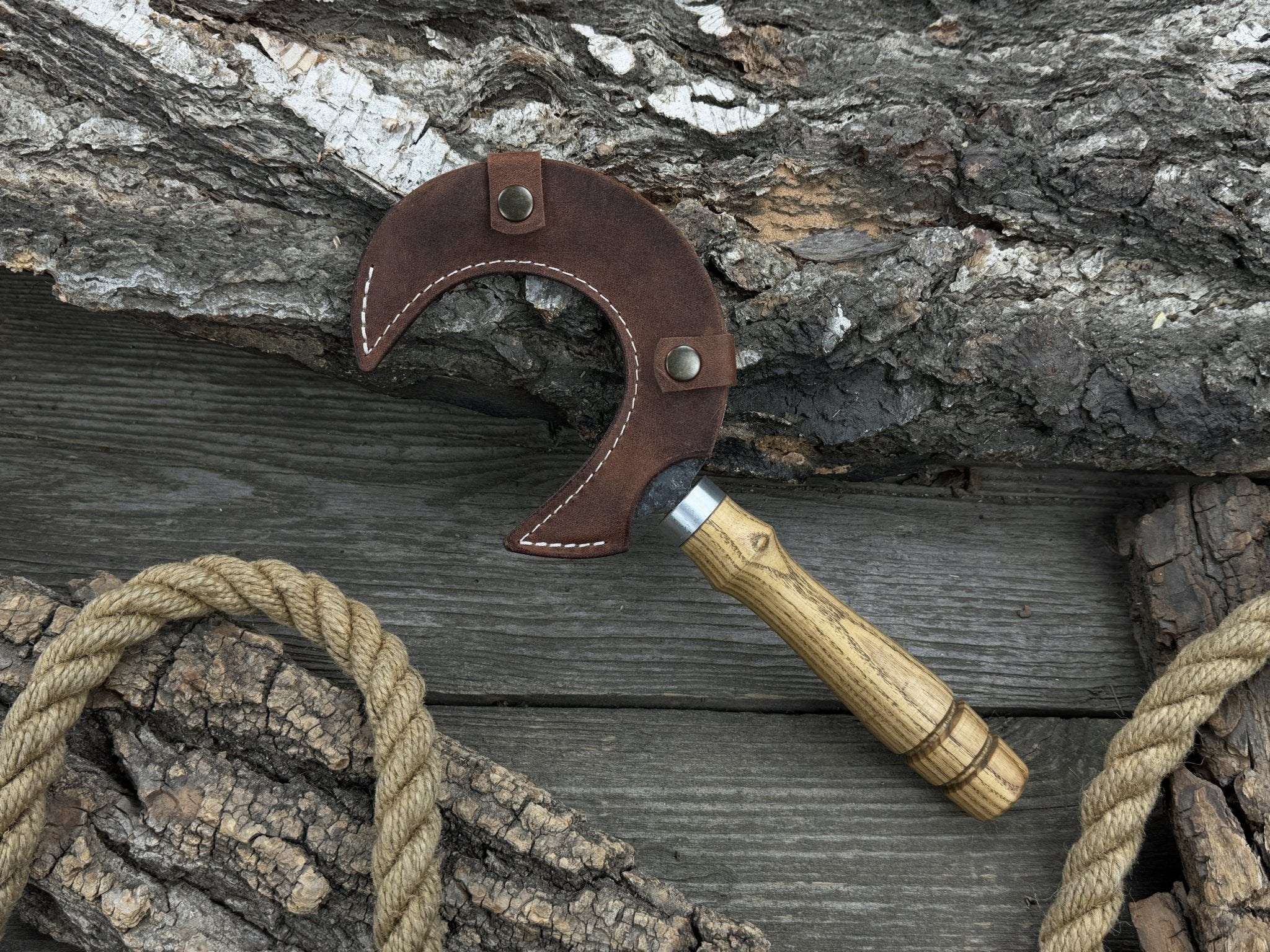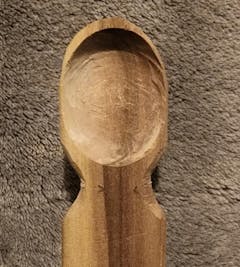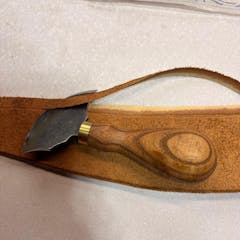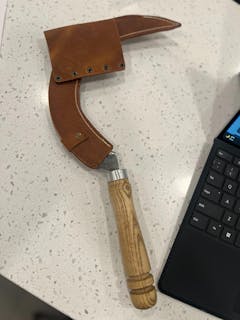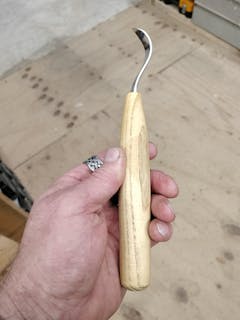Grande faucille forgée à la main, ⌀19 cm (7,5 pouces)
Grande faucille forgée à la main, ⌀19 cm (7,5 pouces)
Grande faucille forgée à la main, ⌀19 cm (7,5 pouces)
Petite faucille forgée à la main, ⌀9 cm (3,54 pouces)
Petite faucille forgée à la main, ⌀9 cm (3,54 pouces)
Grande faucille forgée à la main, ⌀19 cm (7,5 pouces)


Fournitures d'affûtage
Gardez vos outils dans un état optimal pendant des années
La polyvalence des faucilles : un outil indispensable pour tout jardinier
L'histoire de la faucille est étroitement liée au développement de l'agriculture, car une faucille agricole était largement utilisée il y a des centaines d'années pour récolter des cultures comme le riz et le blé, pour couper les céréales et le foin.
Cet outil est encore utilisé aujourd'hui. Les faucilles sont très efficaces dans les zones rurales montagneuses où les agriculteurs récoltent du fourrage coupé pour le bétail. En plus de la récolte des cultures, une faucille de jardinage peut être utilisée pour des tâches de jardinage comme le défrichage des zones envahies par la végétation et la taille des mauvaises herbes. Les lames de la faucille sont généralement courbées et aiguisées sur le bord intérieur, ce qui permet de couper l'herbe et la végétation dense sur un terrain accidenté sans endommager les racines des plantes.
Dans les régions où les outils mécanisés comme les tracteurs sont peu pratiques ou trop chers, les faucilles à main sont toujours préférées pour leur simplicité, leur prix abordable et leur facilité d'entretien. C'est pourquoi les jardiniers modernes les utilisent largement pour les tâches de taille, de récolte et d'élagage, accomplissant ces tâches efficacement et rapidement. Les faucilles sont également des outils nécessitant peu d'entretien ; avec un entretien approprié, elles deviennent un investissement à long terme pour les jardiniers.
Choisir la faucille adaptée à vos besoins
L'un des types de faucilles les plus couramment utilisés aujourd'hui est la faucille de récolte. Elle est connue pour sa lame prononcée et incurvée avec un bord tranchant, unilatéral ou dentelé, pour couper les matériaux fibreux comme l'herbe et les tiges. D'autres versions présentent des bords lisses pour des coupes plus nettes dans les cultures.
La longueur des lames des faucilles de récolte varie de 6 à 12 pouces, ce qui en fait la taille idéale pour un meilleur contrôle et une meilleure précision dans les zones étroites et larges. Ces outils agricoles sont légers pour faciliter les tâches répétitives comme la récolte des céréales lors de longues séances de coupe.
Différents types de faucilles : laquelle vous convient le mieux ?
La sélection de faucilles à main ne se limite pas à la faucille à grains traditionnelle. Voici plusieurs types conçus pour des utilisations spécifiques :
Faucille d'herbe
- Conception de la lame : Lame longue, légèrement incurvée avec un bord dentelé.
- Conception de la poignée : poignées plus longues en bois ou en plastique pour une prise en main confortable.
- Utilisations principales : Conçu pour couper les mauvaises herbes et l'herbe, tailler les bordures de pelouse.
Faucille de désherbage
- Conception de la lame : Lame plus courte et plus courbée avec un bord tranchant pour un travail détaillé.
- Conception du manche : Manches plus courts en bois ou en plastique pour un meilleur contrôle.
- Principales utilisations : Idéal pour couper l'herbe près du sol et autour des buissons sans les endommager.
Brosse Faucille
- Conception de la lame : Lame longue et légèrement incurvée pour couper la végétation dense.
- Conception de la poignée : poignées plus longues pour un meilleur effet de levier.
- Principales utilisations : Convient pour nettoyer les zones envahies par de l'herbe haute, des broussailles et des mauvaises herbes.
Faucille à dents de scie
- Conception de la lame : Dotée de dents en forme de scie pour couper les plantes résistantes.
- Conception du manche : variable, généralement en bois ou en matériaux composites.
- Principales utilisations : Utilisé pour la récolte de plantes fibreuses comme le riz et la tonte.
Faucille de haie
- Conception de la lame : longue, droite ou légèrement courbée avec un bord dentelé.
- Conception de la poignée : poignée plus longue pour une meilleure portée.
- Principales utilisations : Taille et entretien des haies et arbustes.
Faucille Kama japonaise
- Conception de la lame : courte et courbée, souvent fabriquée en acier à haute teneur en carbone pour offrir tranchant et précision.
- Conception de la poignée : Poignée courte pour un meilleur contrôle.
- Principales utilisations : désherbage, récolte et travaux de jardinage détaillés.
Chaque type d'outil de faucille est conçu pour s'attaquer à des tâches agricoles et de jardinage spécifiques, donc le choix du bon outil dépend des tâches que vous devez accomplir.
Caractéristiques clés à rechercher dans une faucille de qualité
Que vous recherchiez une faucille agricole ou une faucille de jardinage, plusieurs critères vous aideront à faire le bon choix :
- Matériau de la lame : une faucille de jardinage est souvent dotée d'une lame en acier inoxydable ou en acier à haute teneur en carbone. L'acier à haute teneur en carbone est durable, conserve son tranchant pendant longtemps et est facile à affûter. Les lames à haute teneur en carbone sont particulièrement efficaces pour couper les plantes résistantes. L'acier inoxydable offre une résistance à la rouille mais s'émousse plus rapidement.
- Conception de la lame : La conception de la lame dépend de la tâche pour laquelle une faucille agricole a été créée. Les lames courbées sont plus adaptées à la coupe de la végétation dense, tandis que les lames droites sont idéales pour une récolte ou une taille précise. Les bords dentelés traitent bien les matériaux fibreux, tandis que les lames à bords lisses permettent des coupes contrôlées pour les cultures comme le blé. Les lames plus courtes (6 à 8 pouces) offrent plus de maniabilité, tandis que les lames plus longues (10 à 12 pouces) couvrent plus efficacement de plus grandes surfaces.
- Conception du manche : les manches en bois, en plastique ou en matériaux composites offrent différents niveaux de durabilité et de confort. Les manches en bois offrent une prise en main naturelle mais nécessitent plus d'entretien que les matériaux composites.
- Durabilité : La connexion entre la lame et le manche doit être solide pour une efficacité durable de la faucille pour le jardinage. Elle peut être fixée soit par une construction à soie, où la lame s'étend dans le manche, soit par un système de rivets solide pour résister à une utilisation intensive.
- Outil de faucille multi-usages : les faucilles multi-usages sont utiles si vous souhaitez un seul outil pour les coupes légères et lourdes. Si vous recherchez la polyvalence, la forme de la lame et le type de matériau sont des éléments clés à prendre en compte.
- Facilité d'entretien : L'entretien d'un tranchant doit être simple et rapide, en particulier lorsqu'un outil agricole à faucille gère des tâches lourdes.
Adaptez la faucille à votre style de jardinage
Si vous vous concentrez principalement sur le jardinage, pensez à faire correspondre votre style de jardinage avec les types de faucilles de jardin qui correspondent à vos besoins :
Jardins naturalisés
Ce style imite les paysages naturels, en se concentrant sur les formes et les textures des plantes plutôt que sur la couleur.
- Types de faucilles à main nécessaires : Les faucilles à herbe avec de longues lames légèrement courbées et des manches plus longs sont parfaites pour gérer de vastes zones d'herbe et de prairies de fleurs sauvages.
Jardins de campagne
Ces jardins présentent des fleurs colorées, des fleurs sauvages et des éléments rustiques.
- Type de faucille de jardin nécessaire : une faucille traditionnelle pour récolter les petites cultures et couper le feuillage dense. Une faucille de désherbage aidera à gérer les mauvaises herbes et à maintenir un jardin bien rangé.
Jardins orientaux
Les jardins orientaux mettent en valeur l’harmonie, l’équilibre et la tranquillité, avec des rochers, des ponts, de l’eau et des plantes soigneusement placées.
- Type d'outil de jardinage en faucille nécessaire : Une faucille japonaise Kama est parfaite pour le désherbage, la récolte et l'entretien général du jardin.
Jardins modernes
Les jardins modernes mettent l’accent sur la simplicité, les formes géométriques et les lignes épurées.
- Type d'outil de faucille nécessaire : Une faucille à haie est parfaite pour tailler les haies et les arbustes afin de garantir des coupes nettes et une apparence précise.
Comment utiliser et entretenir correctement votre faucille
Meilleures pratiques pour une utilisation sûre et efficace de la faucille
Pour utiliser efficacement une faucille, maintenez une prise ferme mais pas trop serrée pour contrôler l'outil sans provoquer de fatigue. Le mouvement de coupe doit être fluide et légèrement incliné pour un meilleur tranchage. Les techniques courantes incluent :
- Balancement latéral : balancez la faucille d'un côté à l'autre, près du sol. Cette méthode est efficace pour couper l'herbe et les mauvaises herbes.
- Mouvement de traction : Positionnez la faucille parallèlement au sol, en poussant légèrement vers le bas pendant que vous la tirez vers l'arrière pour couper l'herbe plus épaisse ou les petits arbustes.
- Mouvement de coupe : Déplacez la faucille dans une trajectoire courbe, en suivant la courbe de la lame pour des coupes nettes lors de la récolte des cultures.
Portez un équipement de sécurité comme des gants résistants et des lunettes de protection pour éviter les coupures accidentelles et les blessures causées par des débris.
Entretien de la faucille : garder votre outil tranchant et durable
Pour garder la lame d'une faucille bien aiguisée :
- Éliminer la rouille : utilisez du papier de verre pour éliminer la rouille superficielle de la faucille à main. Un ponçage manuel sera suffisant si la rouille est minime. Nettoyez la lame après avoir éliminé la rouille.
- Limez la lame : vous pouvez utiliser des pierres humides de différents grains pour cela. Commencez par la pierre grossière pour affûter le tranchant de la lame, puis passez aux pierres plus fines pour le polissage. Maintenez un angle constant de 30 degrés pendant l'affûtage.
- Polissage et affûtage : pour ajouter un aspect brillant et poli à la lame, utilisez une pierre en céramique pour le polissage final à un angle constant et nettoyez la lame après l'affûtage.
Rangez les faucilles avec un protège-lame ou un étui dans un endroit sec pour assurer la durabilité de l'outil.
Erreurs courantes à éviter lors de l'utilisation d'une faucille
Lorsque vous commencez à utiliser une faucille, essayez d’éviter de commettre ces erreurs courantes :
- Négliger l'entretien régulier peut entraîner des lames émoussées et un risque de blessure plus élevé.
- Appliquer une force excessive peut entraîner des blessures. Utilisez plutôt des outils tranchants et pratiquez des mouvements de coupe en douceur.
- Mauvaise prise de la faucille à grains : tenir l'outil trop fermement provoque une tension.
- Ignorer la sécurité en ne portant pas d’équipement de protection, ce qui peut entraîner des coupures et des blessures.
Pourquoi acheter votre faucille chez nous ?
Si vous savez de quel type de faucille vous avez besoin, pensez aux faucilles forgées à la main de Sharky Forged Steel Tools™. Avec des années d'expérience dans la fabrication, nous proposons une gamme de faucilles de jardinage forgées à la main avec des lames de différents diamètres, longueurs et épaisseurs pour répondre à vos besoins.
Nos faucilles sont fabriquées en acier au carbone 52100 (norme ASTM A295), d'une dureté de 59/62 HRC, ce qui garantit que la lame reste tranchante pendant longtemps. L'acier au carbone est facile à affûter et à entretenir, ce qui en fait un investissement précieux pour le jardinage ou l'agriculture.
Le poids moyen de nos faucilles varie de 170 g (5,9 oz) à 210 g (7,4 oz). Les manches sont en bois de frêne, choisi pour sa durabilité, sa légèreté et son confort.
Lorsque vous achetez chez nous, vous pouvez être assuré de la qualité de l'outil, suivre votre expédition et échanger des outils si nécessaire. Vous pouvez également nous contacter via notre formulaire de contact ou par e-mail d'assistance pour toute demande de renseignements. En choisissant Sharky Forged Steel Tools™, vous investissez dans un produit durable et résistant !
